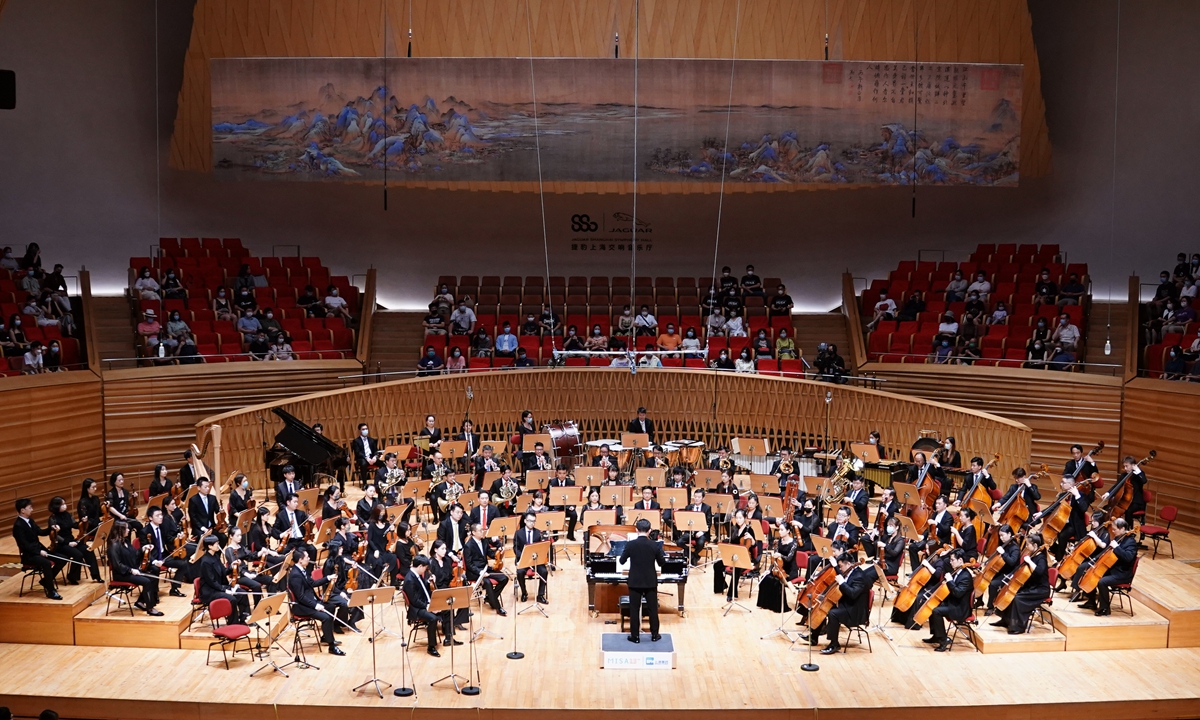Chinese musicians turn landscape masterpiece into epic work of classical music

The Shanghai Symphony Orchestra perform at the Music in the Summer Air concert in Shanghai.Photo: Courtesy of the Shanghai Symphony Orchestra
You never know how romantic and talented Chinese people can be. The only surviving painting by the Northern Song Dynasty's (960-1127) young genius artist Wang Ximeng, A Thousand Li of Rivers and Mountains, is probably the finest example of Chinese blue-green landscape paintings. With bright mineral pigments, the painter depicts a vast country landscape, an ideal world of perfect order and harmony that people dream of. Now, nearly 1,000 years later, Chinese musicians are doing the same thing as Wang, but this time through the art of music.
The musical interpretation of the masterpiece A Thousand Li of Rivers and Mountainsdebuted in Shanghai as the closing performance of the Music in the Summer Air concert by the Shanghai Symphony Orchestra on Sunday. Following the concert, the performance kicked off on Wednesday in Xi'an, Shannxi Province, a nation tour that will include stops in Shenzhen, Guangzhou and Beijing.
"It is an ode to China's traditional culture and philosophy," the piece's composer Zhao Lin told the Global Times on Tuesday.
"Just as Chinese painting aesthetics emphasize the relationship between artistic conception and the viewer's mentality, the music creation can help people understand the landscape and the heaven and sky in our hearts as well as our feelings toward nature and humanity in the form of music."
Under the baton of young conductor Sun Yifan, the symphony orchestra work, which cost Zhao almost a year to finish, took the audience at the theater and thousands more watching online into the world of the splendid scroll painting.
Beauty of China
Every mountain, valley, hill and stream in the painting has a unique appearance and is well arranged with a music-like rhythm throughout the scroll, leaving unlimited room for imagination for the composer, Zhao recalled, who even placed a replica of the painting in his study so he could observe it every day and find inspiration.
Brought up in a family of traditional Chinese painters, Zhao developed a special interest in painting, especially in landscape paintings, at a very young age. The composer said he sees the music piece as another way to express the "beauty of China" in the form of folk music and symphony music. Keeping pace with the original painting, the music interpretation has six chapters, each relying on collaboration between an classic music orchestra adding with Chinese music instruments like the sheng, a reed pipe wind instrument; pipa, a plucked string instrument; erhu, a two-stringed bowed instrument; and the bamboo flute. All contribute to build a harmonious relationship between humans and nature that is deeply rooted in Chinese philosophy.
"Each with its own style, the six chapters of the music piece correspond to the six parts of the painting. From various aspects, they answer two philosophical questions: 'What is China?' and 'What is Chinese?'" Yu Long, the renowned conductor and artistic director of the Shanghai Symphony Orchestra, told the Global Times on Monday.
"Listening to the music piece, everyone in the audience can feel the beauty of China in the composer's heart and awaken patriotic enthusiasm in their hearts. It is an attempt worth cherishing to put Chinese philosophy to music."
As one of China's most popular cities full of vigor and energy, Shanghai is home to hundreds of theaters and livehouses that stage various culture performances from modern musicals to traditional operas every night.
As one of the 23 symphony orchestras in China that commissioned the work, the Shanghai Symphony Orchestra not only took it from a work composed on paper to make it a reality, but did so by inviting Sun, a promising young conductor, to oversee the project.
Calling the project a "Mission Impossible" because he also plays the piano during the fifth chapter, Sun had to make full use of his time and energy to understand not only the music, but also the emotions and feelings that the painter instilled in his work.
"There are many blending moments where water and land meet, which is often seen in landscape paintings. To present the aesthetic feeling that there is no gap between water, sky, clouds and fog, that feeling of everything melting into one, the sound volume of the strings needed to be seamlessly connected when the sheng section ended," he recalled.
Modern mix
The composer absorbed as much inspiration from traditional Chinese culture as he could. The methods that he used in each chapter are similar to the ones used in China's oldest collection of poetry, The Book of Songs, first setting his eye on objects and then transiting from objects to people.
"It's a mixture of classic and modern," he added.
The opening chapter is a pure classical one presented by orchestra, and then the sheng is introduced to present nature and people.
The third chapter, a relative peaceful one, is a concerto dominated by the pipa and orchestra, while the fourth emphasizes the love and broad mind people should have when facing the mighty mountains and rivers. The fifth and the sixth gradually reach a peak with the introduction of the piano and bamboo flute and ends with a soprano solo with lyrics from a poem that features Mount Lushan, which is said to have been the inspiration for Wang's painting.
The delicate arrangement and detailed planning not only wowed the audience, but also was applauded by music professionals as "a musical work with the spirit of Chinese aesthetics."
"The composer is quite the individual, and uses his unique creative techniques to skillfully integrate the pictorial and poetic sentiments of Chinese landscape painting," commented music critic Mao Shi'an.
Photos
Related Stories
- Feature: 2nd edition of Montreux Jazz Festival China ready with aim to connect through music
- Orchestra in Henan revives ancient Chinese music
- Sacred Music Festival held in Athens
- China’s national music heritage reaches wider audience through creative performances combining unique innovations
- In China's Hainan, 86-yr-old artist gives modern makeover to traditional music
Copyright © 2022 People's Daily Online. All Rights Reserved.









